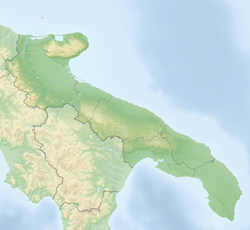| Calcare di Altamura | |
|---|---|
| Stratigraphic range: Coniacian-early Campanian ~ | |
| Type | Geological formation |
| Sub-units | Loferitique, Stromatolique & Gorjanovicia Members |
| Underlies | Calcare di Caranna |
| Overlies | Calcare di Bari |
| Lithology | |
| Primary | Limestone |
| Other | Dolomite |
| Location | |
| Coordinates | 40°48′N16°36′E / 40.8°N 16.6°E |
| Approximate paleocoordinates | 25°00′N15°54′E / 25.0°N 15.9°E |
| Region | Apulia |
| Country | Italy |
| Extent | Apulian Platform |
| Type section | |
| Named for | Altamura |
The Calcare di Altamura (Italian for Altamura Limestone) is a Coniacian to early Campanian geologic formation in Italy. [1] The formation comprises limestones that are highly fractured, in places karstified and dolomitized. Fossil ankylosaur tracks have been reported from the formation. [2]

